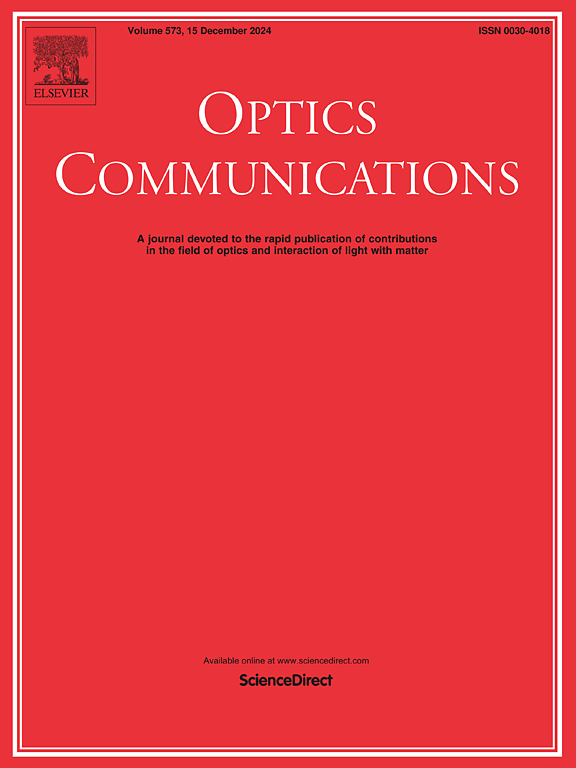使用变压吸收池进行双梳子 IPDA XCO2 测量的校准实验
IF 2.2
3区 物理与天体物理
Q2 OPTICS
引用次数: 0
摘要
测量 XCO2(大气中二氧化碳的柱平均干空气混合比)对于监测气候变化和指导减缓工作至关重要。集成路径差分吸收(IPDA)是一种用于星载激光雷达的高效 XCO2 测量解决方案。然而,有限的波长数量限制了其能力。利用电光频率梳(EOFC)技术增强的 IPDA 提供了一种强大的解决方案。本研究利用非对称和对称的电光双梳光谱(EO-DCS)系统对 1572 nm 波长的 IPDA 测量进行了验证。该室内实验系统并非以真正的激光雷达模式运行,而是侧重于通过透射式电池对 XCO2 进行 IPDA 测量。我们通过可变压力二氧化碳吸收池实现了大气光谱透射,将 425 至 470 mb 的压力与 386.81-447.08 ppm 的 XCO2 相关联。非对称/对称系统的 XCO2 测量结果均表现出极佳的线性。它们的线性拟合得出的均方根误差 (RMSE) 低至 0.198/0.064 ppm,平均绝对百分比误差 (MAPE) 低至 0.0386%/0.0140%。这种水平的测量性能在其他研究中从未出现过。准确度是通过将 IPDA 结果与压力表进行比较来评估的,精确度则是通过重复测量(10 分钟内测量 1000 次)和艾伦方差分析来确认的。值得注意的是,我们的系统在没有稳频的情况下也能有效运行,显示了对激光频率漂移的耐受性--这对于 IPDA 应用来说是一大优势。整个实验是在非对称和对称系统的比较中进行的,尤其是在吸收线残差分析中。我们讨论了从相位到光谱透射率的误差转移及其影响,并解释了为什么非对称系统的残差更大。这些结果凸显了 EO-DCS IPDA 在测量 XCO2 方面的卓越性能及其应用潜力。据我们所知,这是迄今为止唯一一次 DCS IPDA 校准演示。本文章由计算机程序翻译,如有差异,请以英文原文为准。
Calibration experiments for dual-comb IPDA XCO2 measurements using a variable pressure absorption cell
Measuring XCO2, the column-averaged dry-air mixing ratio of CO2 in the atmosphere, is essential for monitoring climate change and guiding mitigation efforts. Integrated Path Differential Absorption (IPDA) is a highly effective XCO2 measurement solution for space-borne lidar. However, the limited number of wavelengths limits its capabilities. IPDA, enhanced with Electro-Optical Frequency Comb (EOFC) technology, offers a robust solution. This study validates IPDA measurements using both asymmetric and symmetric Electro-Optic Dual-Comb Spectroscopy (EO-DCS) systems at 1572 nm. This indoor experimental system does not operate in a true lidar mode, but focuses on IPDA measurements of XCO2 through a transmission-style cell. We achieved atmospheric spectral transmittance by a variable pressure CO2 absorption cell, correlating pressures from 425 to 470 mb to XCO2 of 386.81–447.08 ppm. The XCO2 measurements of asymmetric/symmetric systems both exhibit excellent linearity. Their linear fittings yielded the Root Mean Square Error (RMSE) as low as 0.198/0.064 ppm, and the Mean Absolute Percentage Errors (MAPE) was as low as 0.0386%/0.0140%. This level of measurement performance has never been demonstrated in other works. Accuracy was assessed by comparing IPDA results with a pressure gauge, and precision was confirmed through repetitive measurements (1000 times over 10 min) and Allan variance analysis. Notably, our system operates effectively without frequency stabilization, showing tolerance to laser frequency drift—a significant advantage for IPDA applications. The entire experiment was conducted in a comparison between asymmetric and symmetric systems, especially in the analysis of absorption line residuals. We discuss the error transfer from phase to spectral transmittance and its implications and explained why the residuals in the asymmetric system were larger. These results underscore the superior performance of EO-DCS IPDA in measuring XCO2 and its promising potential for applications. To our knowledge, this is the only DCS IPDA calibration demonstration to date.
求助全文
通过发布文献求助,成功后即可免费获取论文全文。
去求助
来源期刊

Optics Communications
物理-光学
CiteScore
5.10
自引率
8.30%
发文量
681
审稿时长
38 days
期刊介绍:
Optics Communications invites original and timely contributions containing new results in various fields of optics and photonics. The journal considers theoretical and experimental research in areas ranging from the fundamental properties of light to technological applications. Topics covered include classical and quantum optics, optical physics and light-matter interactions, lasers, imaging, guided-wave optics and optical information processing. Manuscripts should offer clear evidence of novelty and significance. Papers concentrating on mathematical and computational issues, with limited connection to optics, are not suitable for publication in the Journal. Similarly, small technical advances, or papers concerned only with engineering applications or issues of materials science fall outside the journal scope.
 求助内容:
求助内容: 应助结果提醒方式:
应助结果提醒方式:


